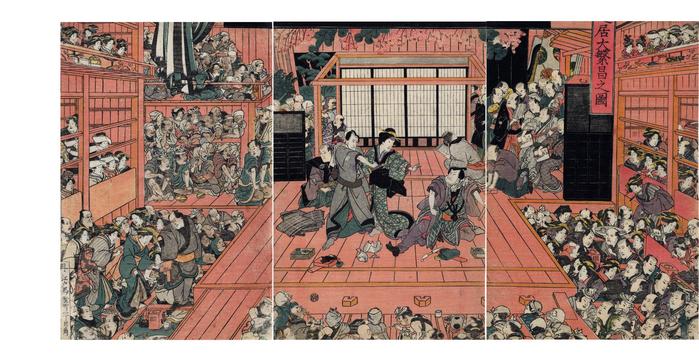Utagawa Toyokuni I (初代歌川豊国) (artist 1769 – 02/24/1825)
A Picture of Great Success (Shibai Daihanjō no zu) - 芝居大繁昌之図
ca 1817
30 in x 14 in (Overall dimensions) Japanese color woodblock print
Unsigned because of trimming on the left
Censor seal: kiwame
Waseda University - right hand panel
National Diet Library - the right and left panels are the same, but the central one is different
Japan Arts Council - the central panel is different
Japan Arts Council - another version with a different central panel
Musée Guimet
Waseda University - left hand panel
Royal Museums of Art and History, Belgium (via Cultural Japan) - left panel only
Östasiatiska Museet, Stockholm - with a different center panel This theater scene is definitely a slice of life. It is loud, raucous and very active. There are several children in the audience. The one on the lower right edge looking down at the theatergoers is more interested in what they are doing than the action taking place on the stage. People are being served food, they are eating and drinking, they are talking, smoking, reading, probably flirting, etc. You know the ordinary things of everyday life. In boxes on the right are a group of high ranking courtesans. You can tell that by their clothing and the number of expensive kanzashi they are wearing in their hair.
On the stage at the back on our right is the orchestra and a singer who looking back at the other singers who are all holding libretti. At least three men are playing the shamisen, one man is holding a hand drum, and one kneeling man listening intently appears to have a piece of wood that he is using to clap the floor.
The drama taking place in center stage in the middle panel shows two actors at odds, with their smoking pouches lying on the ground, a pipe, tobacco kits or trays, and a broken vase.
On our left in the tier above a group of laborers is a woman with a child and a baby who appears to be breastfeeding. Right next to the stage in the corner is a very attentive man wearing eyeglasses. One man at the bottom center of the middle panel is lighting his pipe from a lit one of another man near him.
Shibai (芝居) means drama or play.
****
The example in the National Diet Library is the same on the left and right, but there is a different panel in the center. The left panel of this triptych in the Lyon Collection is trimmed on the left side. The left panel in the NDL is fuller and has the signature of Toyokuni I.
There is a full copy, the same as the one in the Lyon Collection, in the Musée Guimet. That one shows the Toyokuni signature.
Great Success. View of interior of Kabuki theater, in the middle Matsumoto Koshirō V.
****
The publisher is Nishimuraya Yohachi although no seal appears on this triptych. On the left side it shows the address of the publisher: 'Edo Bakuro-cho 2-chrome Kado'.
The example in the Edo-Tokyo Museum shows a different center panel -- it appears that the publisher reused the left and right panels with different center panels for different performances and actors.
****
This triptych is illustrated in a two-page spread in color in Impressions of Ukiyo-e by Dora Amsden and Woldemar von Seidlitz, 2007, pp. 14-15.
Matsumoto Kōshirō V (五代目松本幸四郎: 11/1801 to 5/1838) (actor)
Nishimuraya Yohachi (西村屋与八) (publisher)
actor prints (yakusha-e - 役者絵) (genre)
